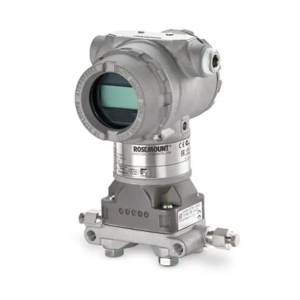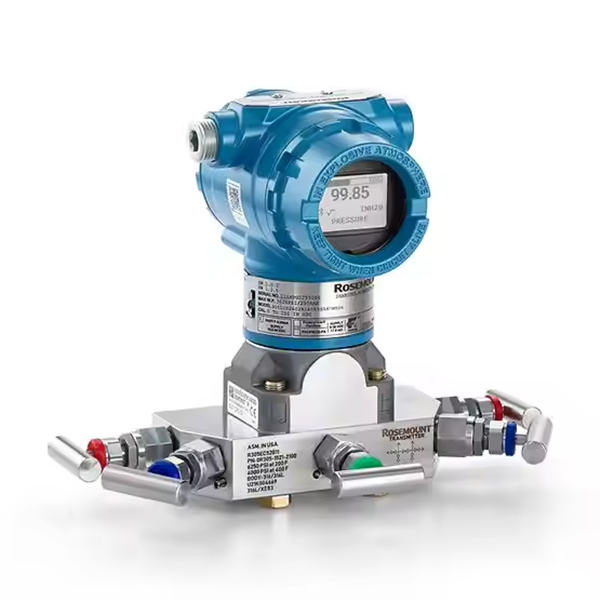Rosemount pressure transmitters are instrument sensors used to measure pressure, liquid level and flow. It detects and controls the pressure value under various working conditions by converting the pressure signal into an electrical signal.
It is mainly composed of a pressure sensor, a preamplifier, a temperature sensor, an analog-to-digital converter and a digital circuit. When the pressure of the measured medium acts on the pressure sensor, it deforms and generates a tiny electrical signal, which is converted by the preamplifier and digital circuit and outputs a standard signal to the receiver, thereby accurately measuring the pressure value under various working conditions.

How do Rosemount pressure transmitters work?
The working principle of Rosemount pressure transmitter is to transfer process pressure to filling fluid through isolation diaphragms and filling fluid on high and low pressure sides, and then the filling fluid transfers pressure to the sensing diaphragm in the center of the sensor. The sensing diaphragm is a tensioned elastic element, and its displacement changes with the pressure. The capacitor plates on both sides detect the position of the sensing diaphragm, and the difference in capacitance between the sensing diaphragm and the capacitor plates is converted into corresponding current, voltage or digital HART (Highway Addressable Remote Transmitter Data Highway) output signal.
Classification
According to different working principles, Rosemount pressure transmitters can be divided into piezoresistive transmitters, capacitive transmitters, piezoelectric transmitters, PMCMEMS pressure sensors, etc.
Pressure transmitter calibration steps and precautions
I. Verification steps
1. Preparation
Before calibrating the pressure transmitter, you need to do the following preparations:
(1) Prepare the pressure source and pressure gauge. The range of the pressure source should cover the range of the pressure transmitter being tested.
(2) Prepare a voltmeter or ammeter to measure the output signal of the pressure transmitter.
(3) Prepare a calibration record sheet to record the calibration results.
2. Preparation before calibration
Before calibrating the pressure transmitter, the following preparations need to be made:
(1) Check whether the appearance of the pressure transmitter is intact and whether there is any damage or dirt.
(2) Check whether the wiring of the pressure transmitter is correct and whether there is any looseness or corrosion.
(3) Check whether the range and accuracy of the pressure transmitter meet the requirements.
3. Calibration process
When calibrating the pressure transmitter, follow the steps below:
(1) Connect the output pipe of the pressure source to the input port of the pressure transmitter.
(2) Connect the output pipe of the pressure gauge to the output port of the pressure transmitter.
(3) Start to increase the pressure, gradually adjust the output pressure of the pressure source, and record the output signal of the pressure transmitter.
(4) Gradually reduce the output pressure of the pressure source and record the output signal of the pressure transmitter.
(5) According to the calibration record sheet, calculate the measurement error and accuracy of the pressure transmitter.
(6) According to the calibration results, adjust the calibration parameters of the pressure transmitter to meet the accuracy requirements.
II. Things to note when calibrating the pressure transmitter
When calibrating the pressure transmitter, you need to pay attention to the following matters:
1. Safety first
When calibrating the pressure transmitter, you need to pay attention to safety to avoid accidents. For example, you should use a pressure source and pressure gauge that meet the requirements to avoid exceeding its rated pressure range; during the pressure increase and pressure reduction process, the output pressure of the pressure source should be adjusted slowly to avoid sudden increase or decrease in pressure.
2. Pay attention to environmental impact
When calibrating the pressure transmitter, you need to pay attention to environmental impact. For example, you should avoid calibrating in an environment with strong electromagnetic fields or strong vibrations to avoid affecting the accuracy of the calibration results.
3. Pay attention to the calibration cycle
The calibration cycle of the pressure transmitter should be determined according to the specific situation. Generally speaking, the calibration cycle should be determined based on factors such as the use environment, use conditions, and frequency of use. For important pressure transmitters, calibration should be carried out regularly to ensure their accuracy and reliability.
Previous: rosemount 1056 Dual Channel Transmitter
Next: no information





